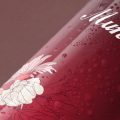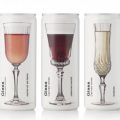Red, bubbly, almost sweet, very low alcohol, organic and to drink chilled. Originally from Italy, a protagonist of parties and trendy events, this wine is now beginning to be seen more frequently in restaurants and pizzerias in Chile as well, to demonstrate its striking reddish foam and how easy it is to drink. Main characteristics? The versatility to adjust to different gastronomic scenarios and the joy it delivers in every glass.
It is clear. If one thinks of a wine with bubbles, the first mental approach is going to be to a spiky glass of sparkling white wine. However, there is more to the frizzante universe than just that. Lambrusco, a red wine with bubbles, of Italian origin with Protected Designation of Origin (PDO), became very famous in the Middle Ages in its native region as the classic accompaniment to bread and salami and is still the wine par excellence in any gathering of friends or family.
It arrived in the country for the first time ten years ago through Tánico Chile, even having to change the local law in order to allow the entry of a wine with such a low alcohol content. As a novel alternative to drink a light and fresh wine, it was conquering the public and word of mouth led it to be sought after by sommeliers and local restaurants, generating new pairing experiences, happiness and enjoyment at the time of eating and drinking, with its marked freshness and red fruit profile.
Although there is no clear date of birth, since Etruscan times there are traces of its cultivation (as it is a vine as well as a style of wine). Thus, the first traces tell of a certain ‘labrusca vitis’, descending from ‘vitis silvestris’, a wild vine present in Italy since ancient times and considered unsuitable for winemaking because of its hardness (the Romans called it ‘vitis labrusca’).
Thus, Lambrusco as a product was born in four vineyard areas of Emilia Romagna: Modena, Parma, Reggio nell’Emilia and Mantova (all with a high content of mineral salts in their soils). And from there it spread to domestic and foreign markets. As for its production, over the years it has also evolved, because while in its beginnings a technique similar to champenoise was used, since 1960 the Charmat method was chosen.
Apart from its striking ruby color, Lambrusco is a wine of totally peculiar characteristics, inimitable and of great versatility. There are more than 60 varieties, but there is no doubt that the most highly valued are those designed to be drunk young. And, in the same way, it does not expect pairings with sophisticated food because it is one of those wines that go well with almost everything.









